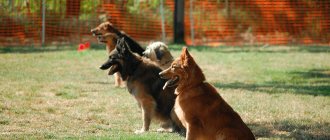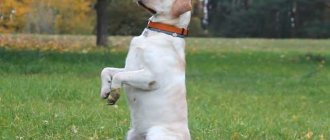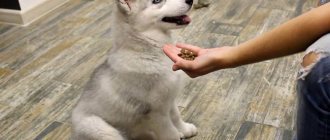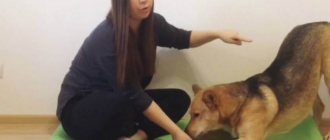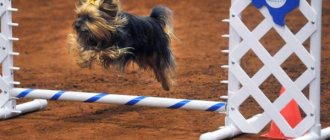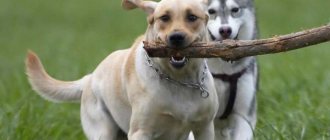The general training course (abbreviated OKD) is a dog training program developed by the domestic dog handler Vsevolod Vasilievich Yazykov in the 1920s. Since that time, the course has remained virtually unchanged, only occasional amendments have been made.
Any dog needs some form of general training. In the process of training, the animal develops obedience and a number of other useful skills that are useful both in everyday life and in professional activities. In most cases, dogs that have not passed the OKD are not allowed to participate in other types of training.
To complete a general dog training course, you can enroll in classes at a local dog training school or contact a private specialist. You can also train your pet on your own, but in this case you will need to find a suitable site, carefully read the rules and regulations for OKD, find out the dates of exams and agree with the instructor.
Let's look at which teams are included in the OKD exam and how to pass the tests successfully.
Preparation for OKD
It is recommended to train your dog 2 times a day before feeding .
The duration of each workout should be no more than 2 hours .
over the age of 12 months are allowed to take the OKD exam .
For the exam, the dog must know the basic commands “Sit”, “Lie down”, “Come to me”, etc.
The number of commands studied in one lesson depends on the preparation of the animal and its level of performance. Usually at first it is enough to study and repeat 2 commands, in the future their number should be increased.
Features of training
Teaching a puppy commands at home should take place in the form of a game. It is better that the puppy at the initial stage of his “education” does not feel the difference between ordinary communication, play and training. For adult dogs, a more serious approach is needed.
Puppy training
How you teach your puppy commands determines his behavior in the future. You should start raising a dog from the age of three months. By this point, the baby should know where his place is and not mess up the house. The main rule of training is that it is strictly forbidden to hit the puppy. If you want to punish, then express your dissatisfaction in a stern voice - this is quite enough.
The main commands with which to start learning: “Come”, “Fu”, “Place”. Training with a young dog should be systematic. You can start with 15-20 minutes a day, later increasing it to 40 minutes. If you train for longer, the dog will simply get tired and will not accept the owner.
During the training process, you should take breaks of 5-10 minutes so that the dog can rest. This applies to both puppies and adult dogs, especially if they have not previously completed a training course.
Adult dog training
Training an adult dog is much more difficult than training a puppy. Firstly, the animal has already developed its own behavioral habits. Secondly, the stage of puberty has occurred, and hormones very often prevent the animal from perceiving the owner’s commands. Thirdly, an adult dog is not as open to new things as a puppy.
However, it is possible to train an adult dog, and there are many positive examples. The main thing is to maintain consistency in your studies, be attentive and patient.
On average, training for basic commands takes from 3 months to a year. When training an adult dog, it is necessary to take into account its temperament and, depending on this, adjust training methods. Try not to show negative emotions or make sudden movements, especially if the dog is prone to aggression, talk to the animal in the process.
It is important to choose the right treat and change locations for walks. It is necessary to emphasize the formation of a trusting relationship between the dog and its owner. This will help both her and you learn the necessary skills faster.
Some owners resort to using electric collars, but this method is considered inhumane. It is possible only under the guidance of a trainer and in the case where the dog poses a danger to others.
What does the exam include?
during the general training course exam :
- movement of the dog next to the owner (assessed throughout the entire test period);
- display of teeth and the dog's attitude towards the muzzle;
- a set of commands “Sit”, “Lie down”, “Stand”;
- the dog’s approach to the owner and return to the place;
- aportation;
- stopping unwanted actions (command “Fu”, refusal to take food from a stranger);
- overcoming a set of obstacles (barrier, stairs, boom, fence or inclined wall);
- attitude towards the shot.
Skill testing can be carried out in any order, with the exception of commands running as a complex.
Team “Nearby”
On the command “Near”, the dog must walk to the left of the owner so that its shoulder is at the level of his leg.
You can find out how to teach this command by reading a separate article on our website - How to teach a dog the “Near” command.
How is a skill tested in the exam? The trainer gives the command “Nearby” with his voice, and then, at the judge’s signal, makes turns on the spot: right, left, around. Next comes the movement, during which the judge checks the dog’s work when changing the pace and direction of walking, as well as when stopping. The animal should walk calmly, and during stops sit at the owner’s left leg without the command “Sit”.
If the dog deviates to the side by more than 2 m, refuses to sit down, or does not make turns, then the judge does not count the skill.
Command “Come to me”
“Come to me” is one of the main commands that should be instilled in an animal from an early age.
You can find out how to teach this command by reading a separate article on our website - How to teach a dog the “Come to me” command.
How is a skill tested in the exam? The trainer gives the command “Come to me” with his voice, accompanying it with a gesture. The dog should immediately run up to the owner and sit at his left leg (it is not necessary to walk around). The animal may be seated in front of the owner. In this case, the trainer additionally commands “Next”, and the dog sits on the left.
When calling your pet after the “Walk” command, before the “Come to me” command, you are allowed to call out to the dog in order to attract its attention. Then the approach time is counted from the moment the command “Come to me” is given, and the score does not decrease.
If the dog does not approach the trainer within 15 seconds, the skill is not counted.
Team “Place”
When training puppies on the command “Place”, the dog is taught to go to its bed. In OKD, the “place” is any object familiar to the dog.
You can find out how to teach this command in the article - How to teach a dog the “Place” command.
How is a skill tested in the exam? The trainer gives the command “Lie down”, places a thing in front of the dog, and then orders “Place” and moves away 15 m. After 30 seconds, the owner calls the animal with the command “Come to me” and with a gesture. Next comes a holding period of 15 seconds, after which the trainer commands “Place” and with a gesture sends the dog to the starting position. The pet must quickly run up to the owner, return to its place and lie down within 1 m of the item. Then the owner approaches the dog and gives the command “Sit”.
If the dog does not return to its place or lies down at a distance of more than 2 m from the object, the skill is not counted.
A set of commands “Sit”, “Lie down”, “Stand”
The dog should be able to perform the commands “Sit” and “Lie down” already at the age of 6 months. The “Stand” command is more complex and its execution must be reinforced for up to 9 months.
You can find out the principle of training in the articles - Command “Sit”, “Lie down”, “Stand”.
How is a skill tested in the exam? The owner orders “Sit”, moves away from the dog 15 m and, using commands given simultaneously by voice and gestures, forces the dog to lie down, stand up and sit down again. Each skill is demonstrated 2 times from different positions.
At the first command, the animal must take the desired position and not change it. Moving forward more than 5 m is regarded as failure to perform the skill. Repeated submission of commands is considered an error and will reduce the score.
Professional education with diploma
Cynological College at the MBA named after. Scriabin (South Eastern Administrative District)
Address: m. Ryazansky Prospekt, st. Academician Skryabina, 23 Website: https://mgavm.ru Phone: Cost: 80,000-130,000 rub.
Students are invited to the secondary vocational education program in the specialty “Cynology”.
Students learn both the theoretical and practical fundamentals of dog training. They graduate with the knowledge and skills to prepare dogs for various services. Study domestic and foreign standards. They know how to properly display animals. Carry out grooming of various breeds. They gain knowledge in the field of dog anatomy and physiology, and first aid.
They select animals correctly, study genetics and the basics of breeding. They can independently prepare diets and analyze feed. Properly equip areas for keeping dogs.
Moscow Construction College No. 38 (South-Western Administrative District)
Address: m. Teply Stan, st. Profsoyuznaya, 154, bldg. 7, 8 Website: https://www.kollege38.ru Phone: 8-495-339-56-22; 339-76-10 Cost: free
The college invites you to receive secondary specialized education in the specialty “Cynology”.
Form of study: full-time, evening, correspondence. The external program will allow not only ninth- and eleventh-graders, but also others who wish to master their chosen specialty, given that college education is free.
Not only boys, but also girls can be dog handlers. Practice has shown that the fair half has proven itself excellent in raising dogs.
“Aport” command
Most dogs master the “Fetch” command without problems, perceiving it as a game.
You can find out how to teach this command in the article - How to teach a dog the “Fetch” command.
How is a skill tested in the exam? The dog stands at the trainer's left leg. He shows her the fetching object, gives the command “Sit” and throws the object forward, at a distance of at least 10 m. Then there is a short delay of about 10 seconds, after which the owner commands “Fetch” using voice and gesture. The dog must run up to the object, take it, quickly return to the owner and sit at his left leg. After some patience, the owner says the command “Give”, and the pet gives the item.
If the dog does not respond to the “Fetch” command, does not bring the object, throws it halfway, plays with it, drops it, and then picks it up again or does not give it to the trainer, the skill is not counted. Also, the command is considered unfulfilled if the pet approaches the owner only on the command “Come to me” and sits at his leg on the command “Sit”. The dog must bring the object and sit down without additional commands.
Why do you need dog training?
Every owner wants to instill certain skills in their pet. For some, it is enough for a four-legged friend to bring slippers and calmly greet guests, others need reliable security, and others need an artist. All puppies are highly trainable, quickly acquiring specific skills with the right approach.
So, what is the purpose of learning commands?
- Educate.
The dog must understand the prohibitions and learn the simplest norms of behavior. This way all family members will feel comfortable around him.
- Discipline.
The four-legged friend, of course, is everyone’s favorite, but he must understand that the person is in charge. The animal gradually begins to respect and listen to the owner.
- Teach.
If a dog was purchased for certain activities (hunting, guarding, guiding), then it needs to be instilled with specific skills. This is usually done by experienced specialists.
The most pleasant bonus of training is the rapprochement between the owner and the animal. While playing happily, they respect and understand each other, which leads to a strong friendship.
Stopping unwanted activities
To stop unwanted actions, use the command “Fu” (“No”, “No”).
You can find out the training scheme in the article - How to teach a dog the “Fu” command.
During the exam, the skill is tested in one of the following ways:
- prohibit the dog from taking food from the owner’s hands;
- prohibited from taking any item.
In the first case, the trainer commands “Sit”, then treats the dog with a treat several times with an open palm. When offering another piece, the owner says “Fu.” This is followed by holding for 5 seconds, after which the trainer removes the treat. In the second case, the owner sends the animal to retrieve the thrown object, and then commands “Fu.” After the command is completed, the item is removed. If the dog takes a treat or object, it must spit it out immediately after the prohibiting command.
If the dog does not respond to 2 “Fu” commands given in a row, the skill is not counted.
It is forbidden
Command "No!" (or “Ugh!”) is also extremely important and begins to be unlearned from a young age, when the dog, while still a puppy, learns to behave as expected (to go to the toilet correctly, not to spoil your things, not to eat from the table, not to bite, etc.). Of course, it is not recommended to hit the puppy (maximum - a slap on the butt), but it is better, like a mother dog, to pat the withers (neck) a little. Moreover, punish and say “You can’t!” always follows at the beginning of an undesirable action being performed, and not when the deed is done and the dog has already forgotten about it. She will not understand why she was punished, and the owner’s actions will at best cause bewilderment. When a puppy eats a sausage that is forbidden to him with all his might, this command will also be ineffective. During the passage of the OKD, a different tactic is in effect. This is a command that must be given only once, and non-compliance is always immediately followed by punishment.
Its unconditional implementation is very important in training any dog. It’s easy to practice this command during training
The pet must be on a leash. Take a small piece of treat and feed it to the animal, and press the next piece in your palm on top with your thumb and menacingly say “No!” The dog may ignore your order and try to get to the food, then you should hit his face with the palm of your hand containing the treat. After the animal, according to this prohibition, begins to refuse the treat, you praise it, but you should not reward it with a “forbidden” treat. These actions are practiced no more than once per training session, as they are very unpleasant for the pet.
When he starts to always carry out this command, you can use it to interrupt other negative actions (barking at passers-by and cyclists, picking through garbage, etc.). When in everyday life a pet always reacts correctly to the word “No!”, he is never rewarded for this.
Important! If you have forbidden your dog to do something, then never allow it again. This is a complete ban, not a brake
It should not be used in all cases. If your pet grabs your scarf, tell him “Give!”, and if he goes in the wrong direction, say “Near!”. If he jumped onto the sofa, on which he was sometimes allowed to rest, but now his presence there is not needed, command “Place!” But in such cases, when the dog shows inappropriate aggression or picks in the trash, there is an unequivocal, firm “No!”
Reaction to shots
A well-trained dog should not be afraid of thunder, firecrackers, gunshots or any other city noise. Many people begin to accustom their pets to loud sounds from a very early age.
You can read how to do this correctly in the article - What to do if your dog is afraid of loud noises.
The animal’s attitude towards shots is checked when performing all OKD skills, except for the “Near” and “Fetch” commands. The shot is fired from a special starting pistol at a distance of 15 m from the dog executing the command.
If the pet stops following commands, gets scared or runs away, the skill is not counted.
- OO training
Which dogs are the smartest and most trainable?
- 10.11.2015
The command “Show your teeth” and attitude towards the muzzle
Absolutely all dogs should know the “Show your teeth” command, regardless of whether they will pass the OKD exam or not. This skill will be useful when going to the veterinarian, brushing teeth and participating in exhibitions. Along with showing the bite, the dog's reaction to the muzzle is checked.
You can read how to teach an animal to calmly accept a muzzle in the article - How to teach a dog to wear a muzzle.
How is a skill tested in the exam? The owner approaches the judge, gives the command “Show your teeth,” then puts a muzzle on the dog and commands “Walk.” After this, the trainer calls the animal and removes the muzzle.
If the dog does not follow the command, refuses to put on the muzzle, or tries to remove it, the skill is not counted.
Why do all puppies need an obedience course?
Obedience is the best thing you can do to develop rapport between you and your puppy.
- A basic obedience course makes your puppy's life easier by setting boundaries for possible behavior and thereby eliminating misunderstandings between you. After completing the Obedience course, your puppy will know his place in the world and will be able to distinguish his correct behavior from the incorrect one.
- The Obedience course will be interesting for both you and your puppy.
- Your puppy will grow into a calm and confident dog who can be taken with you everywhere and is a pleasure to be around.
- Develops mutual trust between you and your puppy. Your puppy will know what you expect from him and that you will always treat him fairly.
Obedience is an important moment in a puppy's life, it stimulates his mental abilities and the need to communicate with you.
